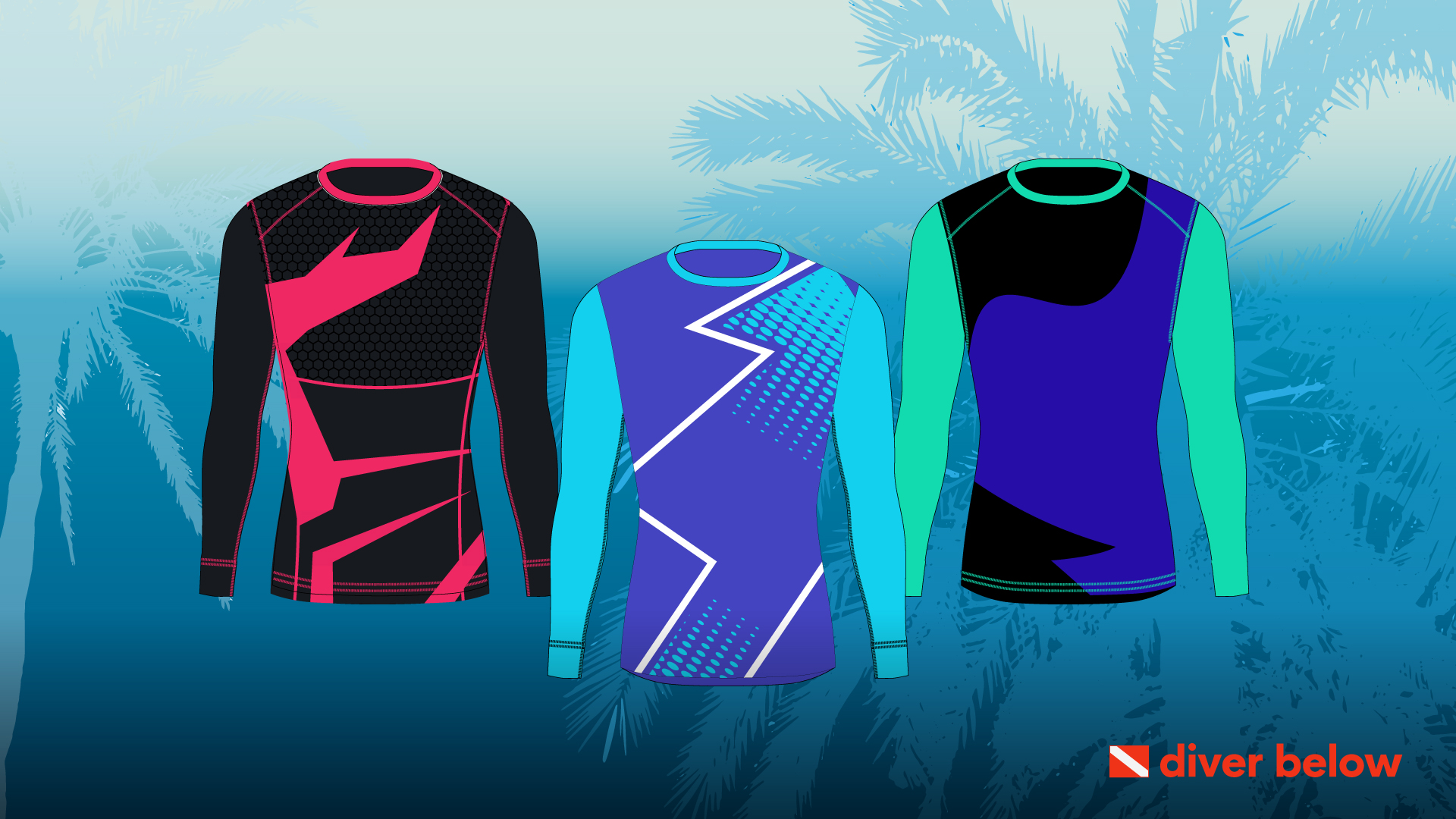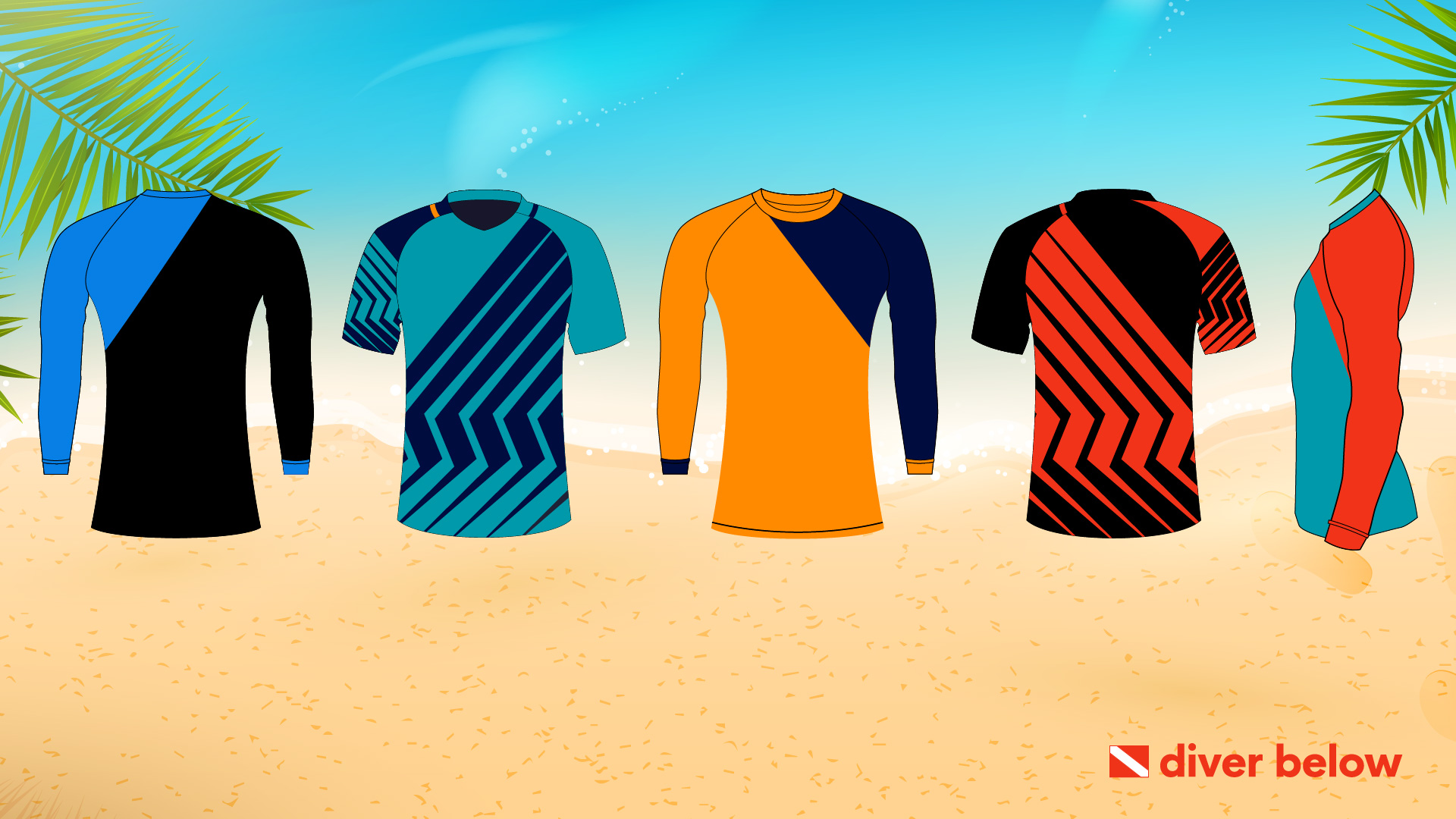Swimming, surfing, or diving might seem like activities that do not require a lot of safety gear.
The truth is that you might create better experiences in water if you wear certain pieces of clothing, such as a rash guard.
Such a simple piece of clothing can do a lot for you in the water.
You might even find that a rash guard comes in handy in other activities besides swimming.
But what is a rash guard and what do you need to know about them?
We’ll cover everything you need to know and more below.
Contents
- What is a Rash Guard?
- What Does a Rash Guard Do?
- Is a Rash Guard Necessary?
- Types of Rash Guards
- Styles of Rash Guards
- Rash Guard Materials
- Uses for Rash Guards
- Is a Rash Guard the Same as a Wetsuit?
- What is the Difference Between a Rash Guard and a Swim Shirt?
- Using a Rash Guard
- Taking Care of a Rash Guard
- Frequently Asked Questions
- Wrapping Up
What is a Rash Guard?

A rash guard is a shirt or suit made from the same materials as swimsuits, and acts as a versatile piece of protective clothing for any water sport.
They come in both long sleeve and short sleeve form.
These types of exposure suit are a staple in any collection of diver’s gear.
Suggested Read
- Scuba Gear: Everything you will need to go scuba diving.
- Snorkel Gear: Everything you will need to go snorkeling.
What Does a Rash Guard Do?
People either use it to protect from sunlight, chafing during surfing, or even give thermal protection in cooler waters.
Depending on the materials your rash guard is made of, you could see benefits such as sweat-wicking or quick-drying.
In some cases, a rash guard can act as a change of clothes after a swimming activity.
The tight fit keeps your muscles warm by trapping heat against your skin, and the moisture-wicking fabric quickly dries up any water on your skin.
Is a Rash Guard Necessary?
Depending on the water sport, or the condition of the water, a rash guard may certainly be helpful.
If you are going to be on the water for an extended period, it is great for sun protection.
They are also comfortable to wear since they wick sweat and dry fast.
Plus, if you are an avid surfer, they can help protect your skin from chafing.
Chafing or irritation can occur when you hit surface water or waves very fast, or when you rub up against a sand-covered surfboard.
A rash guard is not necessary, per se, but it can save you a lot of discomfort and perhaps even prevent injury.
For example, if you need to carry a sandy surfing board, it would be helpful to have a long sleeve rash guard to protect both your body and your arm from chafing.
Types of Rash Guards
Although all rash guards serve the same purpose, you can use different types for various occasions.
1. Thermal Rash Guards
Thermal rash guards help specifically with keeping you warmer in the water.
Regular rash guards are made up of nylon, polyester, spandex, and other comfortable, stretchable fabric.
However, thermal rash guards include neoprene, a thicker material that helps retain warmth.
It might not retain as much warmth as, say, a wetsuit, but it should help protect you for longer periods than a regular rash guard.
2. Protective Rash Guards
A protective rash guard is another name for a regular rash guard.
It does not include a thicker material to keep you warm but instead protects your skin from sun and surfing irritation.
Styles of Rash Guards
Although a rash guard is supposed to protect you, it does not mean you cannot be stylish while wearing one.

1. Cropped Rash Guards
If you have ever seen a crop top, a cropped rash guard has the exact same style.
The shirt may have a long or short sleeve, but the wearer’s bellybutton shows.
2. Rash Guard Shirts
A rash guard shirt is the most common sort of rash guard.
They come in all styles for men, women, and kids, with a long or short sleeve.
They offer sun protection and help with chafing.
3. Rash Guard Bodysuits
A rash guard bodysuit has a few stylistic additions.
Rather than being just a shirt, it is a swimsuit with long sleeves.
Sometimes, a rash guard bodysuit might have pant legs.
You can choose bodysuits that go all the way down the leg or just above the knee.
Suggested Resource
Best Rash Guards: a hand-curated list of the best rash guards for divers and swimmers
Rash Guard Materials
Rash guard materials come in safe, comfortable, and lightweight varieties, such as nylon, polyester, spandex, Lycra, and so on.
These allow the rash guard to dry out fast, wick sweat, and keep the wearer lightweight while surfing.
Uses for Rash Guards
We have talked a lot about rash guards as swimming gear, but they are used for other things too.
1. MMA & Jiu Jitsu
Some people use rash guards as training gear in mixed martial arts, or MMA.
Their tough fabrics help prevent abrasions to the skin without ripping or tearing.
Plus, a tight-fitting piece helps keep your muscles warm during exercise, so you do not accidentally injure yourself.
In some cases, rash guards can help prevent the spread of germs and disease.
During previous grapples, you might not have worn protective gear and got a burn on the mat.
If germs came in contact with that burn, you could get sick.
Rash guards prevent you from getting burns or scrapes, and some even have antimicrobial properties to kill germs on contact.
2. Swimming, Surfing, and Diving
As you might have guessed swimming, surfing, and diving is the main sport for rash guards.
People like using them for these water sports because they are tight-fitting, like a swimsuit, and help one feel comfortable in the water for long periods.
Besides protecting from chafing, they help keep you warm in chilly waters.
You might wear one until you warm your body up, or for the duration of your whole swim.
Is a Rash Guard the Same as a Wetsuit?
A rash guard, while similar to a wetsuit, is not the same thing.
A wetsuit is supposed to help keep you warm in the water, while a rash guard is supposed to protect you from physical injury, such as a scratch.
You are more likely to wear a wetsuit while scuba-diving, staying in the water for several hours, or if you are swimming in colder waters.
A rash guard is better suited for surfing since you are dealing with sandy surfaces and rough water landings.
It is not meant to hold a layer of warm water close to your skin, like a wetsuit should.
That said, you can always keep a rash guard on hand when you get out of your wetsuit.
A dry rash guard can help keep you warm by wicking away moisture and protecting against wind.
What is the Difference Between a Rash Guard and a Swim Shirt?
When you compare a rash guard and a swim shirt, the biggest difference is the fit.
While a rash guard is tight-fitting to better protect your skin, a swim shirt is a tad looser.
That is because a swim shirt is supposed to give you UV protection.
It might protect you from UV rays, but not from physical abrasions.
Using a Rash Guard
Now that we know what rash guards are all about, we need to know how to use one.
Luckily, it does not take a rocket scientist to figure out how to use a rash guard.
What to Wear Under a Rash Guard
Most people tend to wear a bikini top or a one-piece swimsuit beneath their rash guard.
In some cases, you might choose to wear your rash guard as your actual swimsuit or swimsuit top.
It is all a matter of personal preference and how modestly you want to dress.
Wearing a rash guard directly on top of your skin will not cause harm.
However, if you wear a full-body rash guard, you might want to wear a swimsuit or swim bottoms beneath for hygienic purposes.
How Should a Rash Guard Fit?
A rash guard is supposed to fit like a compression shirt, which presses against the muscles and promotes faster healing after a workout.
In other words, make sure your rash shirt fits tight to your skin, but is still comfortable to wear.
Taking Care of a Rash Guard
Most people tend to neglect taking care of their swimwear, so it gets stretched out and loses its elasticity.
It is a good idea to not make the same mistake with a rash guard.
How Long do Rash Guards Last?
When properly cared for, a rash guard can last between 3 to 5 years.
How to Take Care of a Rash Guard
Taking care of a rash guard is just like taking care of your other swimsuits.
When you are done swimming, it is a good idea to wash the suit out.
If you have been in the ocean, it is especially important to wash the saltwater out, as this can cause elasticity loss.
Remember that water by itself will not get saltwater or chlorine out of a suit.
Make sure you wash your suit with a gentle soap and warm tap water.
One tip is to turn the swimsuit inside out and wash it there so the outer layer does not get damaged.
Do not use a washing machine to wash your rash guard.
You want to be completely gentle with it, so always wash it by hand.
Do not even try to use the gentle cycle if your machine has it.
You especially do not want to use a dryer on your rash guard.
Let it hang out to dry in your bathroom or anyplace at room temperature.
Do not use a hair dryer or hang your rash guard in direct sunlight.
Frequently Asked Questions
Before we wrap up, here are a few brief answers to some commonly asked questions about rash guards.
Do rash guards work for running?
There is no hard and fast rule for whether or not you can use a rash guard for running.
Some people enjoy using them because they can add an extra layer of warmth if you run in cold places.
You might even wear a short sleeve rash guard beneath your running shirt.
On the other hand, other people have experienced chafing running with such a tight-fitting piece.
You might have to come to your own conclusion about whether rash guards work for running.
Do rash guards have built-in bras?
Sadly, even rash guards made for women do not have built-in bras.
Your best bet to create that support is to wear a swim top beneath the rash guard.
Do rash guards make you hot?
If rash guards are supposed to protect you from injury, the likelihood of them making you feel hot is not high.
If you layer other tops and swimsuits underneath them, you might feel a little warmer, but you will not get hot.
Wrapping Up
Rash guards make awesome pieces of protection when you are on the water, whether because you are surfing, diving, or swimming.
In some cases, you might find that they make nice practice clothing for MMA or jiu jitsu.
As long as you take care of them, they will last you through several adventures out on the water, or on the mat.




